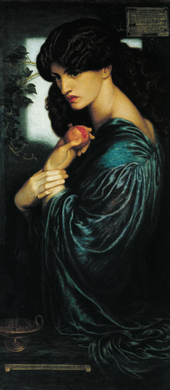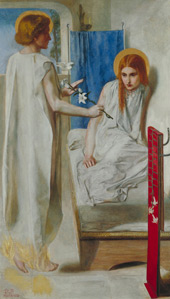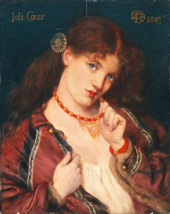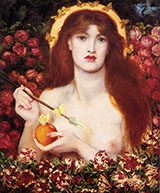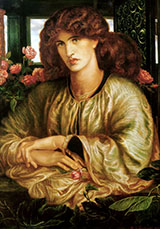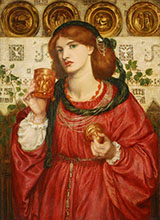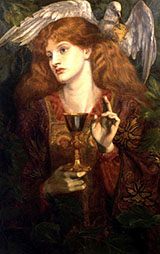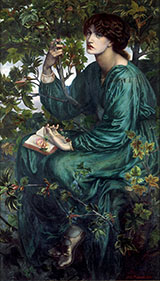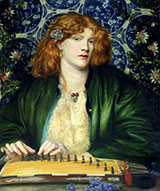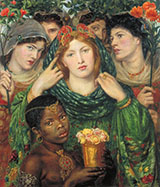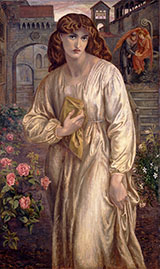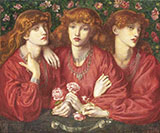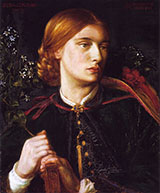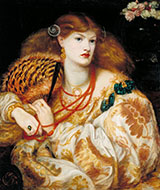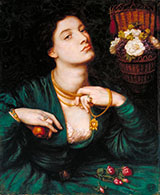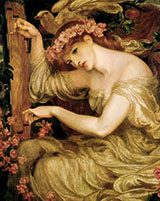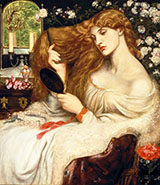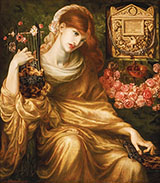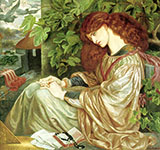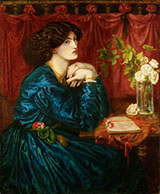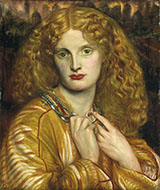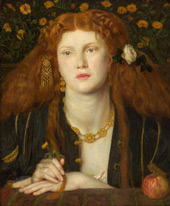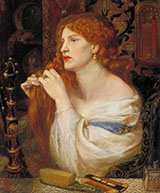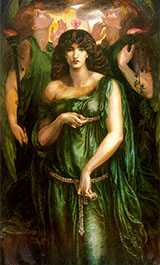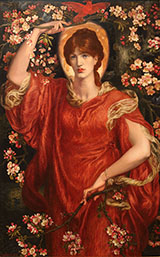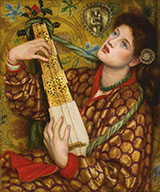Dante Gabriel Rossetti Oil Painting Reproductions
Dante Gabriel Rossetti replica paintings on Canvas for sale
Dante Rossetti and the Pre Raphaelite Brotherhood.
Dante Gabriel Rossetti was born in London on May 12th, 1828. Dante is a famous artist and a leading English poet and illustrator. He founded the Pre Raphaelite Brotherhood with John Everett Millais and William Holman Hunt. The group was formed in 1848 by seven men who preferred to refer to themselves as a “brotherhood.” Inspired by the Nazarenes, the pre raphaelites rejected any mechanical approaches to art. Instead, they lived in a spiritual, Christian manner implementing early Italian Renaissance ideals of painting.
The Nazarenes enjoyed great detailing, complex compositions, and intense jewel-like colors. They believed that Classical Art and Renaissance oil paintings by the artist Raphael had corrupted academic art. Hence the name Pre-Raphaelite, i.e., before the Italian Renaissance artist Raphael. The group was aligned with the critic John Ruskin, who was intensely religious. Therefore, Christian and literary themes are commonplace in Dante Gabriel Rossetti paintings. Initially, the Pre Raphaelite Brotherhood met with strong critical opposition. Dante Rossetti sold many of his watercolors and smaller oil paintings privately and avoided exhibitions for most of his life, even after receiving critical acclaim.
Who is Dante Gabriel Rossetti?
He was the son of an exiled Italian scholar, Gabriele Pasquale Giuseppe Rossetti. Rossetti was born in London in 1828. His younger sister, Christina Rossetti, also wrote poems, and his other sister, Maria Francesca Rossetti, was a nun in an Anglican Religious Order while also writing poetry. William Michael Rossetti, Dante's brother, was also a founder of the Pre Raphaelite Brotherhood. Rossetti studied at King’s College School on the Strand and discovered a love of literature. From a young age, Dante Gabriel Rossetti longed to be a poet and an artist. He enrolled at the Henry Sass Drawing Academy and later studied at the Antique School of the Royal Academy of Arts.
After leaving the Royal Academy, Dante was mentored by Ford Madox Brown, and they remained lifelong friends. In 1850, Rossetti met Elizabeth Siddal, and they married in 1860. She often modeled for Pre Raphaelite paintings, famously appearing in John Everett Millais painting of Ophelia. Siddal’s bright auburn hair and beautifully striking face are common in many of Dante Gabriel Rossetti's famous paintings.
Dante Gabriel Rossetti Famous Paintings.
After Elizabeth Siddal's early death, Rossetti often portrayed Alexa Wilding, who was very similar in appearance to his deceased wife. Wilding worked as a full-time model for Rossetti from 1865 onwards and appeared in the following Rossetti oil paintings:
- The Loving Cup 1867
- Venus Verticordia 1868
- The Women’s Window 1879
Other notable Rossetti sitters included Fanny Cornforth and Jane and May Morris, the wife and daughter of William Morris; Jane Morris appears in two Dante Rossetti paintings: Jane Morris, The Blue Silk Dress 1868, and The Day Dream 1880. The Day Dream is a masterpiece of Pre-Raphaelite painting; Jane holds the stem of a honeysuckle plant, a symbol of love in the Victorian era. However, the oil painting could refer to a secret affair between Rossetti and Morris. Dante Gabriel Rossetti's paintings evoke his love for medieval lore and literature. Despite this, from the 1860s onwards, he painted more close-up portraits of his lovers, Jane Morris and Fanny Cornforth. Fanny Cornforth became the epitome of eroticism and symbolic stylism in works such as Bocca Baciata,Lips That Have Been Kissed.
Dante Gabriel Rossetti Poems
Two poems, My Sister’s Sleep and The House of Life Sonnets, characterize the complex interplay between thought and feeling. Dante Gabriel Rossetti paintings and poetry are inextricably interlinked with some Dante Rossetti paintings illustrating poems. Rossetti exhumed his poems from his wife’s grave at the behest of friends and published them as a collection in 1870. To Rossetti’s dismay, however, they faced critical disapproval. Their sensuality, eroticism, and spirituality offended Victorian sensibilities. He sank into a deep depression later in life and struggled with increasing drug addiction and alcohol abuse. In 1872 Rossetti experienced a mental breakdown as a direct result of this criticism and left his residence with Jane Morris at Kelmscott Manor.
How did Dante Gabriel Rossetti die?
In 1862, tragedy hit when Rossetti’s wife, Elizabeth Siddal, died. She took an overdose of Laudanum, most likely suicide, after suffering a miscarriage. Gabriel Dante Rossetti became increasingly depressed and buried many unpublished poems with his wife at Highgate Cemetery. Soon after Siddal’s death, Rossetti moved to Cheyne Walk in Chelsea, where he lived for the next twenty years. His lover Fanny Cornforth took her own rooms nearby. Rossetti spent his last years as a near-complete recluse. He died on April 9th, 1882, aged 53, due to kidney disease, having also suffered from alcohol-related psychosis.
Dante Gabriel Rossetti reproduction oil paintings wonderfully capture the richness of Victorian art. One of the largest collections of Pre-Raphaelite paintings is held by the impresario and composer Andrew Lloyd Webber. His art collection also includes many famous pre raphaelite paintings by Edward Burne Jones and William Holman Hunt.
Discover Pre Raphaelite art reproductions by famous Pre Raphaelite artists John William Waterhouse and John Maler Collier.
Cannot Find What You Are Looking For?
Reproduction Gallery Information
Customer Service
(Send Us A Message)
Tel: (503) 937 2010
Fax: (503) 937 2011


